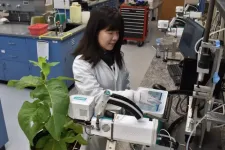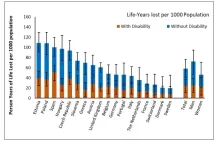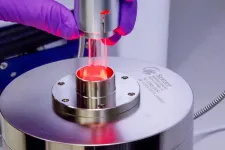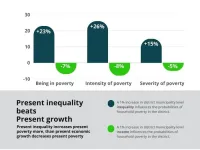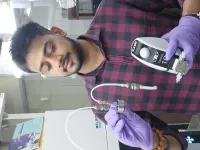(Press-News.org) Charging forward at top speed, a garden snail slimes up 1 millimeter of pavement per second. By this logic, Beckman Institute for Advanced Science and Technology researchers’ new 3D printing process speeds past existing methods — at a snail’s pace.
Researchers in Beckman’s Autonomous Materials Systems Group created “growth printing,” which mimics tree trunks’ outward expansion to print polymer parts quickly and efficiently without the molds and expensive equipment typically associated with 3D printing. Their work appears in the journal Advanced Materials.
“Humans are incredibly talented at making things. Completely new manufacturing processes are hard to find. Growth printing is entirely new, which is thrilling,” said Sameh Tawfick , a professor of mechanical science and engineering at the University of Illinois Urbana-Champaign and project lead.
Tawfick said the most common industrial manufacturing technology is injection molding, where molten polymers take shape in a metal mold. Though effective for mass production, maintaining the molds and curing ovens (where the plastic hardens) can be cost-prohibitive and unwieldy — especially for large objects like boat hulls or fan blades. Additive manufacturing, which prints 3D objects like a layer cake, is mold-less and ideal for custom parts like prosthetics.
“Polymer 3D printing equipment has matured, but there are still aspects that make it expensive and very slow,” Tawfick said. “Our goal was to increase the manufacturing speed, size and material quality while maintaining a low cost. This process that we came up with is truly fast and inexpensive.”
First, Sameh and his colleagues pour amber-colored liquid resin called dicyclopentadiene, or DCPD, into an open glass container submerged in ice water. They heat a center point in the resin to 70C. As the reaction takes over, heat radiates outward from the original point of contact at 1 mm/s, more than 100 times faster than the desktop 3D printers available for home use and 60 times faster than the world’s fastest-growing species of bamboo. Everything the heat touches hardens into a growing sphere, like if the mythical King Midas seized the Earth’s core. Self-sustained by heat’s steady release, the reaction — called frontal ring-opening metathesis polymerization and nicknamed FROMP — uses minimal energy to harden the resin into its solid form: poly- dicyclopentadiene, or p-DCPD.
As the hardened sphere grows, the researchers alter its shape by pulling it out of the resin like an apple out of gooey caramel. Since the liquid-to-solid reaction only happens below the surface, the researchers can lift, dip or spin the solid part like blown glass to manipulate its size and shape. For example: to create a corrugated, or wavy, edge, the researchers lift the resin slightly, hold it still, and repeat.
The researchers designed their process to mimic how a tree steadily expands outward, ring by ring. In nature, elements like gravity, wind and temperature complement and complicate a tree’s tendency to grow symmetrically, resulting in trees that bow in the wind or reach toward a patch of sunlight in the forest canopy.
Tawfick became enamored of living organisms’ growth patterns and resulting shapes — also known as morphogenesis — upon reading D'Arcy Wentworth Thompson’s book, “On Growth and Form.” Last August, when Tawfick was promoted from associate professor to full professor, he dedicated the book to the University Library.
Using their new method, Tawfick and his colleagues fabricated everyday items such as a pinecone, a raspberry and a squash. These are all axisymmetrical shapes, or symmetrical around a vertical axis. Non-symmetrical shapes are more difficult, but possible; for example, the researchers sculpted a kiwi bird by allowing the spherical body to expand below the surface before pulling it up just in time to create a diminutive head and minute beak.
“It is a beautiful and simple application of a reaction-diffusion process, which is found in many natural systems. The speed and energy efficiency of the growth-printing process make this process particularly attractive. On the modeling side of this collaborative project, we developed a computational tool that predicts the upward motion of the rod needed to achieve a target shape of the manufactured object,” said Philippe Geubelle, Illinois professor of aerospace engineering and co-author on the paper.
This method’s limitations are the same ones found in nature. Printing curved objects, like bananas, is theoretically possible but difficult to program mathematically, as are complex shapes “like a thorn in a rose,” Tawfick said.
“It’s hard to find a perfect cube in nature. I don’t know of any plant or organism that looks like a perfect cube. Similarly, our process cannot make a perfect cube. It’s an interesting mirror of nature,” he said.
Tawfick says the process is “simple and highly marketable” and hopes it can one day be used to create large polymer-based products like wind turbine blades. The project is funded through the U.S. Department of Energy Office of Science Basic Energy Sciences program.
“Basic energy science could lead to transformative manufacturing, meaning something with a transformative impact on our economy. This is a successful example and was made possible through collaboration here at the Beckman Institute with people from all areas of expertise,” Tawfick said.
First author and Illinois graduate student Yun Seong Kim said the project demonstrated true teamwork:
“It was really a work of true teamwork, because it required expertise in various backgrounds and we all came together to make it happen,” he said.
Coauthor Randy Ewoldt, the Alexander Rankin Professor of Mechanical Science and Engineering at Illinois, adds: “The many advances of this work resulted because of the outstanding teamwork. The Illinois culture of collaborative excellence shines bright.”
Editor's notes:
The paper titled “Morphogenic growth 3D printing” can be accessed online at https://doi.org/10.1002/adma.202406265 or upon request.
For full author information, please consult the publication.
Contact Sameh Tawfick: tawfick@illinois.edu
END
Nature-inspired 3D-printing method shoots up faster than bamboo
A simple, energy-efficient 3D-printing process takes its cues from trees to manufacture polymers quickly and inexpensively.
2025-03-11
ELSE PRESS RELEASES FROM THIS DATE:
Scientists create a type of catalog, the ‘colocatome,’ of non-cancerous cells’ influence on cancer
2025-03-11
Even cells experience peer pressure.
Scientists have long studied the ins and outs of cancer cells to learn more about the disease, but they’re increasingly finding that noncancerous cells near the cancer cells exert a powerful influence over a tumor’s trajectory.
“Not all cells in a tumor are cancer cells — they’re not even always the most dominant cell type,” said Sylvia Plevritis, PhD, chair of Stanford Medicine’s department of biomedical data science. “There are many other cell types that support tumors.”
To better capture the whole picture of cells’ locations and interactions, Plevritis ...
MSU researchers use unique approaches to study plants in future conditions
2025-03-11
As major changes continue for our planet’s climate, scientists are concerned about how plants will grow and adapt.
Researchers in the MSU-DOE Plant Research Laboratory, or PRL, Sharkey lab are studying changes in plant metabolism that occur when plants are grown in high light, high CO2 (HLHC) conditions.
They found that under these conditions, plants photosynthesize more, which can lead to larger plants, and potentially larger crop yields. However, there are tradeoffs; scientists also found that plants lose carbon under these conditions, which they need to make food. This ...
More than marks: How wellbeing shapes academic success
2025-03-11
With Australia’s National Assessment Program (NAPLAN) beginning today, new research from the University of South Australia highlights a critical but often overlooked factor in student success – wellbeing.
In a world first* study of more than 215,000 students, UniSA researchers found that while standardised tests measure academic skills, different dimensions of wellbeing - emotional wellbeing, engagement, and learning readiness - can play a crucial role in performance.
Specifically, the study found that learning readiness - which includes foundational skills such as perseverance, confidence, and engagement ...
Study quantifies loss of disability-free years of life from COVID-19 pandemic
2025-03-11
Among 289 million adults in 18 European countries, more than 16 million years of life were lost from 2020 through 2022 due to the COVID-19 pandemic, according to a new study published March 11th in the open-access journal PLOS Medicine by Sara Ahmadi-Abhari of Imperial College London, UK, and colleagues.
The direct and indirect impacts of the COVID-19 pandemic on both total and disability-free years of life lost are important for policy setting and resource allocation, but they have not been thoroughly investigated.
In the new study, researchers ...
Butterflies choose mates because they are more attractive, not just easier to see
2025-03-11
A simple neural change alters mating preferences in male butterflies, aiding rapid behavioral evolution, Nicholas VanKuren and Nathan Buerkle at the University of Chicago, US, and colleagues, report March 11th in the open-access journal PLOS Biology.
Heliconius are a group of tropical butterflies known for their wide variety of wing patterns and colors, which act as a warning to predators. Because wing coloration is crucial for their survival, males have evolved a preference for females with the same wing color. But the sensory and neurological mechanisms behind these preferences are poorly understood.
Researchers ...
SwRI receives $3 million NASA astrobiology grant to study microbial life in Alaska’s arctic sand dunes
2025-03-11
SAN ANTONIO — March 11, 2025 —Southwest Research Institute (SwRI) has received a three-year, $2,999,998 million grant from NASA to identify and characterize life and its biosignatures in frozen sand dunes in Alaska, under conditions similar to dune fields on early Mars and Saturn’s moon Titan. The Assessing Regional Reflectors of Astrobiology in Kobuk dunes for Interplanetary Science (ARRAKIS) project team, which includes researchers from Brigham Young University and the University of California—Davis, seek insight into ...
Inequality destroys the benefits of positive economic growth for the poor
2025-03-11
A unique analysis of district-level data reveals why inequality is so destructive to the home consumption welfare of people living below the poverty line, especially during times of significant economic decline, such as the COVID-19 pandemic. During negative economic growth, the welfare of the poor should be the main focus area.
Research from the University of Johannesburg shows how inequality can demolish most of the benefits of positive economic growth and social grants for people living in poverty, especially during economic downturns.
The study by Prof ...
HSS presents innovative research aimed at faster recovery after knee surgery at AAOS Annual Meeting
2025-03-11
At this year’s American Academy of Orthopedic Surgeons (AAOS) annual meeting, investigators at Hospital for Special Surgery (HSS) presented several significant studies, with three focused on new ways to help patients recover faster after total knee arthroplasty (TKA), also known as knee replacement surgery.
What follows are highlights from these studies:
Limiting Use of Tourniquets During Knee Replacement Surgery Improves Patient Outcomes
Tourniquets have traditionally been used during TKA to reduce blood loss and the need for transfusions. However, a new study of almost 18,000 patients from 2019 to 2023 found that prolonged tourniquet use was linked ...
Advancing catalysis: Novel porous thin-film approach developed at TIFR Hyderabad enhances reaction efficiency
2025-03-11
Catalytic function and its efficiency play a significant role in industrial reactions, and consistent reforms are made in the methodology to enhance the large-scale synthesis of drugs, polymers, and other desired products. Available catalysts can be homogeneous, which means that they possess the same phase as the reactants and products, making them difficult to separate from the reaction mixture. On the other hand, heterogeneous catalysts are a preferred choice for such reactions because of their ease of separation and reusability.
The past decade has seen the emergence of porous ...
Small, faint and 'unexpected in a lot of different ways': U-M astronomers make galactic discovery
2025-03-11
A discovery made by a team led by researchers at the University of Michigan tugs at the seams of some key cosmic lessons we thought we had learned from our own galaxy.
This new knowledge comes from the outskirts of Andromeda, the Milky Way's nearest major galactic neighbor, where astronomers have found the system's smallest and dimmest satellite galaxy to date.
This dwarf galaxy, named Andromeda XXXV and located roughly 3 million light-years away, is forcing astronomers to rethink how galaxies evolve in different cosmic environments and survive different epochs of the universe.
Although the discovery bears ...
LAST 30 PRESS RELEASES:
Tracing the quick synthesis of an industrially important catalyst
New software sheds light on cancer’s hidden genetic networks
UT Health San Antonio awarded $3 million in CPRIT grants to bolster cancer research and prevention efforts in South Texas
Third symposium spotlights global challenge of new contaminants in China’s fight against pollution
From straw to soil harmony: International team reveals how biochar supercharges carbon-smart farming
Myeloma: How AI is redrawing the map of cancer care
Manhattan E. Charurat, Ph.D., MHS invested as the Homer and Martha Gudelsky Distinguished Professor in Medicine at the University of Maryland School of Medicine
Insilico Medicine’s Pharma.AI Q4 Winter Launch Recap: Revolutionizing drug discovery with cutting-edge AI innovations, accelerating the path to pharmaceutical superintelligence
Nanoplastics have diet-dependent impacts on digestive system health
Brain neuron death occurs throughout life and increases with age, a natural human protein drug may halt neuron death in Alzheimer’s disease
SPIE and CLP announce the recipients of the 2025 Advanced Photonics Young Innovator Award
Lessons from the Caldor Fire’s Christmas Valley ‘Miracle’
Ant societies rose by trading individual protection for collective power
Research reveals how ancient viral DNA shapes early embryonic development
A molecular gatekeeper that controls protein synthesis
New ‘cloaking device’ concept to shield sensitive tech from magnetic fields
Researchers show impact of mountain building and climate change on alpine biodiversity
Study models the transition from Neanderthals to modern humans in Europe
University of Phoenix College of Doctoral Studies releases white paper on AI-driven skilling to reduce burnout and restore worker autonomy
AIs fail at the game of visual “telephone”
The levers for a sustainable food system
Potential changes in US homelessness by ending federal support for housing first programs
Vulnerability of large language models to prompt injection when providing medical advice
Researchers develop new system for high-energy-density, long-life, multi-electron transfer bromine-based flow batteries
Ending federal support for housing first programs could increase U.S. homelessness by 5% in one year, new JAMA study finds
New research uncovers molecular ‘safety switch’ shielding cancers from immune attack
Bacteria resisting viral infection can still sink carbon to ocean floor
Younger biological age may increase depression risk in older women during COVID-19
Bharat Innovates 2026 National Basecamp Showcases India’s Most Promising Deep-Tech Ventures
Here’s what determines whether your income level rises or falls
[Press-News.org] Nature-inspired 3D-printing method shoots up faster than bambooA simple, energy-efficient 3D-printing process takes its cues from trees to manufacture polymers quickly and inexpensively.
